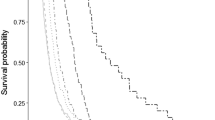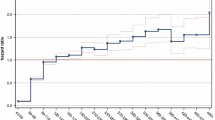Abstract
Introduction There is increasing evidence that staying active is an important part of a recovery process for individuals on sick leave due to musculoskeletal disorders (MSDs). It has been suggested that using part-time sick-leave rather than full-time sick leave will enhance the possibility of full recovery to the workforce, and several countries actively favor this policy. The aim of this paper is to examine if it is beneficial for individuals on sick leave due to MSDs to be on part-time sick leave compared to full-time sick leave. Methods A sample of 1,170 employees from the RFV-LS (register) database of the Social Insurance Agency of Sweden is used. The effect of being on part-time sick leave compared to full-time sick leave is estimated for the probability of returning to work with full recovery of lost work capacity. A two-stage recursive bivariate probit model is used to deal with the endogeneity problem. Results The results indicate that employees assigned to part-time sick leave do recover to full work capacity with a higher probability than those assigned to full-time sick leave. The average treatment effect of part-time sick leave is 25 percentage points. Conclusions Considering that part-time sick leave may also be less expensive than assigning individuals to full-time sick leave, this would imply efficiency improvements from assigning individuals, when possible, to part-time sick leave.
Similar content being viewed by others
Notes
Exchange rate (2009-06-04) 1 Swedish krona = €10.78.
RFV drew data on individuals starting a sick-leave period the same 2-week period for several years in order to analyze and follow individuals assigned to sick leave at the same 2-week period across different years. As described we have access to the 2002 sample of this data.
In practice, we expect that there is a little bit of both, with the aim here to identify the size of the causal effect.
It has been showed that identification is achieved even if the same exogenous regressor appears in both equations, provided this regressor is sufficiently variable, so that theoretical identification does not require availability of any additional instrument in x 1i [19].
References
Hogstedt C, Bjurvald M, Marklund S, Palmer E, Theorell T. Den höga sjukfrånvaron—sanning och konsekvens (The sick-leave epidemic—truth and consequences). Statens Folkhälsoinstitut R 2004:15 (Swedish National Institute of Public Health). 2004.
SBU. Sjukskrivning—orsaker, konsekvenser och praxis: En systematisk litteraturöversikt. SBU – Statens beredning för medicinsk utvärdering (The Swedish Council on technology assessment in health care) Available at: http://wwwsbuse/upload/Publikationer/Content0/1/sjukskrivning/sjukskrivninghelarappdf. 2003.
Nyman K, Bergendorff S, Palmer E. Den svenska sjukan— sjukfrånvaron i åtta länder (The Swedish Sickness – sickness absence in eight countries). Stockholm: Regeringskansliet, Finansdepartementet (Ministry of Finance), Ds; 2002. p. 49.
Försäkringskassan. Social insurance in figures 2008. Försäkringskassan (Swedish Social Insurance Agency). Available at: http://www.forsakringskassan.se/filer/publikationer/pdf/sfis08-epdf. 2008.
OSHA. Work-related musculoskeletal disorders: prevention report. European Foundation for the improvement of living and working conditions. Available at: http://oshaeuropaeu/en/publications/reports/TE8107132ENC. 2008.
Cheng ASK, Hung LK. Randomized controlled trial of workplace-based rehabilitation for work-related rotator cuff disorder. J Occup Rehabil. 2007;17:487–503.
Gross AR, Goldsmith C, Hoving JL, Haines T, Peloso P, Aker P, et al. Conservative management of mechanical neck disorders: a systematic review. J Rheumatol. 2007;34:1083–102.
Hagen KB, Jamtvedt G, Hilde G, Winnem MF. The updated Cochrane review of bed rest for low back pain and sciatica. Spine. 2005;30:542–6.
Schonstein E, Kenny D, Keating J, Koes B, Herbert RD. Physical condition programs for workers with back and neck pain: a Cochrane systematic review. Spine. 2003;28:E391–5.
van Tulder M, Becker A, Bekkering T, Breen A, Gil de Real MT, Hutchinson A, et al. European guidelines for the management of acute nonspecific low back pain in primary care. Eur Spine J. 2006;3(suppl 2):169–91.
Franche R-L, Cullen K, Clarke J, Irvin E, Sinclair S, Frank J. Workplace-based return to-work interventions: a systematic review of the quantitative literature. J Occup Rehabil. 2005;15:607–31.
Sieurin L, Josephson M, Vingård E. Partiell eller hel sjukskrivning, konsekvenser för individen, delrapport 1: Redovisning av deskriptiva data (Partial of full-time sick leave, consequences to the individual). In: Rapport 1/2007 Akademiska Sjukhuset. Uppsala Universitet; 2007.
Andrén D, Andrén T. How to evaluate the impact of part-time sick leave on the probability of recovering? Medium Econom Appl. 2008;17(2):8–13.
Martimo K-P, Kaila-Kangas L, Kausto J, Takala E-P, Ketola R, Riihimäki H, et al. Effectiveness of early part-time sick leave in musculoskeletal disorders. BMC Musculoskelet Disord. 2008;9:23. doi:10.1186/471-2474-9-23.
Scheel IB, Hagen KB, Herrin J, Carling C, Oxman AD. Blind faith? The effects of promoting active sick leave for back pain patients: a cluster-randomized controlled trial. Spine. 2002;27:2734–40.
Heckman J. Dummy endogenous variables in a simultaneous equation system. Econometrica. 1978;46:931–59.
Maddala GS. Limited dependent and qualitative variables in econometrics. Cambridge: Cambridge University Press; 1983.
Jones A. Applied econometrics for health economists. Oxford: Radcliffe Publishing; 2007.
Wilde J. Identification of multiple equation probit models with endogenous dummy regressors. Econ Lett. 2000;69:309–12.
Staiger D, Stock JH. Instrumental variables regression with weak instruments. Econometrica. 1997;65:557–86.
Buddin R, Kapur K. The effect of employer-sponsored education on job mobility: evidence from the U.S. Navy. Ind Relat. 2005;44(2):341–63.
Aakvik A, Holmas TH, Kjerstad E. A low-key social insurance reform-effects of multidisciplinary outpatient treatment for back pain patients in Norway. J Health Econ. 2003;22(5):747–62.
Alexandersson K, Leijon M, Akerlind I, Rydh H, Bjurulf P. Epidemiology of sickness absence in a Swedish county in 1985, 1986 and 1987. A three year longitudinal study with focus on gender, age and occupation. Scand J Soc Med. 1994;22:27–34.
Arrelöv B, Borgquist L, Ljungberg D, Svärsudd K. Do GPs sick-list patients to a lesser extent than other physician categories? A population-based study. Family Pract. 2001;18:393–8.
Peterson S, Eriksson M, Tibblin G. Practice variation in Swedish primary care. Scand J Prim Health Care. 1997;15:68–75.
Soderberg E, Alexandersson K. Sickness certificates as a basis for decisions regarding entitlement to sickness insurance benefits. Scand J Public Health. 2005;33(4):314–20.
Cameron C, Trivedi P. Microeconometrics using Stata. College Station: Stata Press; 2009.
Bound J, Jaeger D, Baker R. Problems with instrumental variables estimation when the correlation between the instruments and the endogenous explanatory variables is weak. J Am Stat Assoc. 1995;90(430):443–50.
Acknowledgments
The authors gratefully acknowledge financial support from the Swedish Council for Working Life and Social Research. The funding source is a Swedish government research agency that initiates and supports basic and applied research with a view to improving our knowledge about working life, public health and welfare. The funding source had no influence in the design, analysis or in the preparation of the manuscript.
Conflict of interest
None declared.
Author information
Authors and Affiliations
Corresponding author
Rights and permissions
About this article
Cite this article
Andrén, D., Svensson, M. Part-Time Sick Leave as a Treatment Method for Individuals with Musculoskeletal Disorders. J Occup Rehabil 22, 418–426 (2012). https://doi.org/10.1007/s10926-011-9348-7
Published:
Issue Date:
DOI: https://doi.org/10.1007/s10926-011-9348-7




